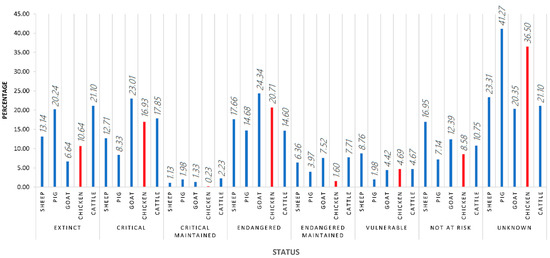Conservation of local breeds possessing genetic variations specific to the particular environment is essential for sustainable development. Although they exist as numerically small populations, local breeds are not only highly adapted to the natural environment, but are also an integral part of the lifestyle of the rural people. People, livestock and environment form a delicately balanced but sustainable ecosystem, and thus the potential impact of any intervention to improve production in the traditional system should be predetermined. The situation is less sensitive in periurban, industrial and small-scale intensive poultry production, in which rapid improvements can be achieved through well-designed development programmes. The intensive poultry production sector, however, is generally much smaller than the family poultry sector in virtually all developing countries. The present review evaluates twenty years (2001 to 2021) of the study of growth and performance in local chicken breeds worldwide. The assessment of methodological approaches and their constraints when intending to fit for data derived from often endangered autochthonous populations was performed. The evaluation of conditioning factors on the impact that publications reporting on research progresses in the field have on the scientific community and how such advances are valued suggests the need to seek new methodological alternatives or statistical strategies. Such strategies must meet the requirements of local populations which are characterized by reduced censuses, a lack of data structure, highly skewed sex ratios, and a large interbreed and variety variability. The sustainable conservation of these populations cannot be approached if scientific knowledge on their productive behaviour is not reinforced in a manner that allows distinctive products to be put on the market and be competitive.
- native breeds and varieties
- nonlinear modelling
- growth curves
- poultry
1. Introduction

2. Growth and Performance in Local Chicken Breeds and Varieties
This entry is adapted from the peer-reviewed paper 10.3390/ani11092492
References
- FAO. Domestic Animal Diversity Information System (DAD-IS): Data; FAO: Rome, Italy, 2021.
- FAO. Sustainable Development Goals: Goals; FAO: Rome, Italy, 2021.
- Hoffmann, I. Livestock genetic diversity and climate change adaptation. In Proceedings of the Livestock and Global Climate Change 2008, Hammamet, Tunisia, 17–20 May 2008; Volume 76.
- Hu, Y.; Cheng, H.; Tao, S. Environmental and human health challenges of industrial livestock and poultry farming in China and their mitigation. Environ. Int. 2017, 107, 111–130.
- Moges, F.; Mellesse, A.; Dessie, T. Assessment of village chicken production system and evaluation of the productive and reproductive performance of local chicken ecotype in Bure district, North West Ethiopia. Afr. J. Agric. Res. 2010, 5, 1739–1748.
- Delgado Bermejo, J.V.; Martínez Martínez, M.A.; Rodríguez Galván, G.; Stemmer, A.; Navas González, F.J.; Camacho Vallejo, M.E. Organization and management of conservation programs and research in domestic animal genetic resources. Diversity 2019, 11, 235.
- Sponenberg, D.P.; Martin, A.; Couch, C.; Beranger, J. Conservation strategies for local breed biodiversity. Diversity 2019, 11, 177.
- Gandini, G.; Hiemstra, S.J. Farm animal genetic resources and the COVID-19 pandemic. Anim. Front. 2021, 11, 54.
- Leroy, G.; Baumung, R.; Notter, D.; Verrier, E.; Wurzinger, M.; Scherf, B. Stakeholder involvement and the management of animal genetic resources across the world. Livest. Sci. 2017, 198, 120–128.
- González Ariza, A.; Navas González, F.J.; Arando Arbulu, A.; León Jurado, J.M.; Barba Capote, C.J.; Camacho Vallejo, M.E. Non-parametrical canonical analysis of quality-related characteristics of eggs of different varieties of native hens compared to laying lineage. Animals 2019, 9, 153.
- Alderson, G. Conservation of breeds and maintenance of biodiversity: Justification and methodology for the conservation of Animal Genetic Resources. Arch. Zootec. 2018, 67, 300–309.
- Taylor, P.S.; Hemsworth, P.H.; Groves, P.J.; Gebhardt-Henrich, S.G.; Rault, J.-L. Ranging behaviour of commercial free-range broiler chickens 1: Factors related to flock variability. Animals 2017, 7, 54.
- González Ariza, A.; Arando Arbulu, A.; Navas González, F.J.; Ruíz Morales, F.d.A.; León Jurado, J.M.; Barba Capote, C.J.; Camacho Vallejo, M.E. Sensory preference and professional profile affinity definition of endangered native breed eggs compared to commercial laying lineages’ eggs. Animals 2019, 9, 920.
- Narınc, D.; Aksoy, T.; Karaman, E.; Curek, D.I. Analysis of fitting growth models in medium growing chicken raised indoor system. Trends Anim. Vet. Sci. 2010, 1, 12–18.
- Shahbandeh, M. Projected Poultry Meat Consumption Worldwide from 2021 to 2030. Statista. July 2021. Available online: https://www.statista.com/statistics/739951/poultry-meat-consumption-worldwide/ (accessed on 16 July 2021).
- Sariyel, V.; Aygun, A.; Keskin, I. Comparison of growth curve models in partridge. Poult. Sci 2017, 96, 1635–1640.
- Lupi, T.; León, J.; Nogales, S.; Barba, C.; Delgado, J. Genetic parameters of traits associated with the growth curve in Segureña sheep. Animal 2016, 10, 729–735.
- González Ariza, A.; Nogales Baena, S.; Lupi, T.M.; Arando Arbulu, A.; Navas González, F.J.; León Jurado, J.M.; Delgado Bermejo, J.V.; Camacho Vallejo, M.E. Characterisation of biological growth curves of different varieties of an endangered native hen breed kept under free range conditions. Ital. J. Anim. Sci. 2021, 20, 806–813.
